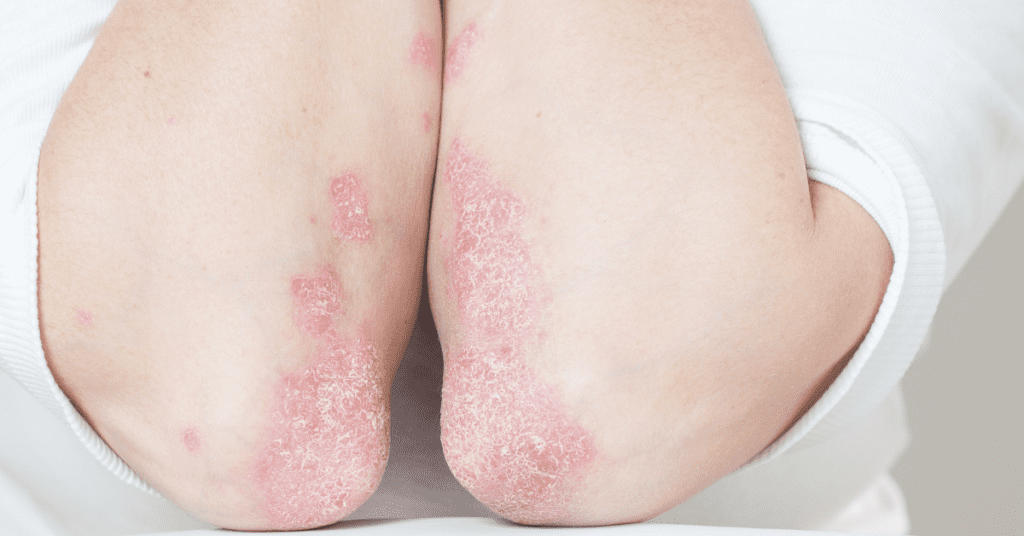Psoriasis and psoriatic arthritis (PsA) are related autoimmune conditions. Psoriasis causes red, scaly skin patches, while PsA leads to joint pain and swelling, often affecting those with psoriasis. They share an immune system dysfunction causing inflammation. About 30% of people with psoriasis develop PsA, and genetics play a role in their development. While psoriasis primarily affects the skin, PsA targets the joints. Interestingly, severity in one doesn’t predict severity in the other. Treatment involves specialists like dermatologists for skin symptoms and rheumatologists for joint issues. Understanding this link helps in better management and care for individuals affected by these conditions.

Common signs and symptoms:
- Joint Pain and Stiffness: Typically affects the joints closest to the nails (fingers, toes), larger joints like knees, and ankles, and may involve the spine (spondylitis). Pain and stiffness often worsen in the morning or after periods of inactivity.
- Swelling and Tenderness: Joints become swollen, tender to the touch, and may feel warm. In severe cases, joints may become red and inflamed.
- Psoriasis Skin Changes: Many individuals with psoriatic arthritis have psoriasis—a skin condition characterized by red, scaly patches that can appear on various parts of the body, including elbows, knees, scalp, and lower back.
- Nail Changes: Nail abnormalities are common, such as pitting (small dents), discoloration, crumbling, or detachment of the nails from the nail bed.
- Fatigue: Persistent fatigue and a feeling of general unwellness are often reported by individuals with psoriatic arthritis, possibly due to the body’s chronic inflammation.
- Tendon and Ligament Pain: Inflammation can affect the areas where tendons and ligaments attach to bones, causing pain and discomfort.
- Morning Stiffness: Stiffness and reduced joint mobility in the morning or after periods of rest are common, lasting for more than 30 minutes.
- Reduced Range of Motion: Over time, joint damage and inflammation may lead to reduced flexibility and limited range of motion.
Ayurveda and Psoriatic Arthritis
In Ayurveda, skin diseases are collectively considered under a common term of Kushtha. Most of the formulations described in Kushtha chikitsa have efficiently been used by physicians to treat different skin ailments. According to Ayurvedic principles, psoriatic arthritis is a result of aggravated Vata and Pitta doshas, leading to Ama or toxins built up in the body. The treatment approach in Ayurveda revolves around restoring dosha equilibrium and eliminating ama through diet modifications, herbal therapies, and detoxification procedures.
Clinical experiences and studies suggest that individuals adopting Ayurvedic interventions experience improvements in psoriatic arthritis symptoms. These include reduced joint pain, stiffness, and a decrease in psoriatic skin lesions. Ayurvedic dietary recommendations, specifically tailored to counter dosha imbalances, involve anti-inflammatory foods while avoiding triggers like processed foods, red meat, and alcohol.
Can Psoriatic Arthritis and Psoriasis Be Cured in Ayurveda?
Ayurveda perceives psoriatic arthritis and psoriasis as manifestations of imbalances within the body’s Tridoshas—Vata, Pitta, and Kapha. The treatment revolves around restoring this equilibrium through diet, lifestyle modifications, herbal remedies, and therapies. Ayurveda interventions aim to manage symptoms effectively and improve overall health. According to Ayurveda, both systemic and local treatments are necessary. Vata-khaphhar Chikitsa-Kushtahara Chikitsa should be applied first and then, Panchakarma Chikitsa, and Rasayanas are advised to reduce the chances of recurrence. These are the different Ayurveda treatment modalities in psoriatic arthritis.
Personalized management plans integrate dietary modifications, lifestyle adjustments, and herbal formulations. Regular adherence to these plans yields positive outcomes in managing the chronicity and severity of psoriatic arthritis. Herbal remedies and formulations play a significant role in the Ayurvedic management of chronic diseases. Herbs such as Neem, Turmeric, Guduchi, etc are known for their anti-inflammatory, immune-modulatory, and detoxifying properties. Herbs like these aim to reduce joint inflammation, alleviate pain, and address the underlying imbalance.
Panchakarma involves a series of cleansing procedures to eliminate toxins and restore dosha balance. Techniques such as Virechana (therapeutic purgation) and Basti (medicated enemas) are utilized to detoxify and rebalance the system, potentially offering relief from joint symptoms.
Case Study: How Did Psoriatic Arthritis Get Better
Mr. K.P., a 42-year-old male with a five-year history of psoriasis and progressively worsening joint pain, sought Ayurvedic intervention due to persistent symptoms impacting daily activities. Our Ayurveda doctors at AyurVAID assessed the patient’s signs of aggravated Vata and Pitta doshas, revealing joint tenderness, skin lesions, and systemic inflammation. A personalized treatment plan was devised, emphasizing dietary modifications, herbal formulations, and Panchakarma therapies. The patient adhered to the recommended diet, focusing on anti-inflammatory foods and herbal supplements. Panchakarma procedures, such as Virechana and Basti, were administered to eliminate accumulated toxins and restore dosha balance. Over six months, Mr. K.P. reported significant improvements, including reduced joint pain and swelling, increased mobility, and regression of psoriatic skin lesions. Regular follow-ups and adjustments to the Ayurveda treatment protocol were made, and the patient continued to sustain these improvements and reported a significant reduction in reliance on conventional medications for symptom management.
This case highlights the potential efficacy of Ayurveda in addressing psoriatic arthritis by targeting underlying imbalances through Apollo AyurVAID’s integrative approach. The details of the patient are kept confidential on purpose.






